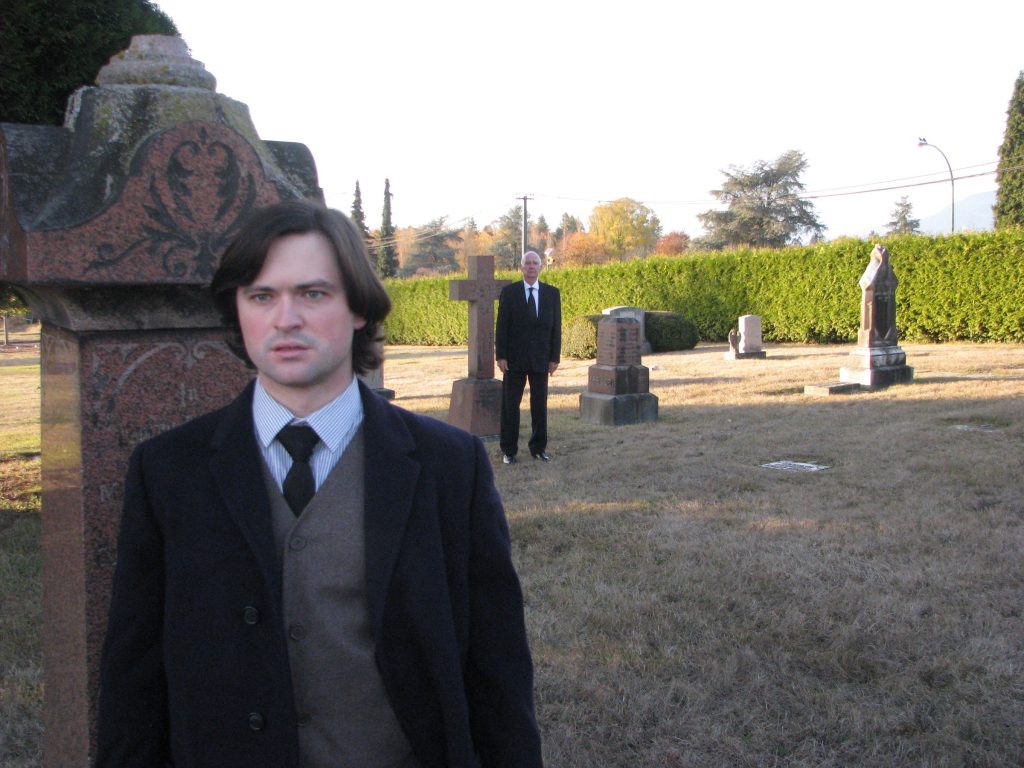
At Jericho Arts Centre to March 5, 2023
Tickets from $27.96 at www.womaninblackvancouver.com
Posted February 26, 2023
In The Woman in Black, aging Arthur Kipps repeatedly tells the young character called the Actor, “I am not an actor” but, of course, Bernard Cuffling, in the role of old Kipps, is most assuredly an actor and a damned fine one. He is an actor so skilled you can believe, for example, that the character he plays is NOT an actor (like a skilled skater who pretends he can’t skate) but is just an old solicitor with a terrible story to tell, haltingly – even reluctantly.
Adapted for stage by Stephen Mallatratt in 1987 from the 1983 novel by Dame Susan Hill, The Woman in Black is a play-within-a-play-within-a-memoir. Old Kipps, urged by his stepchildren on Christmas Eve to tell a ghost story, cannot bring himself to relate the horror story in which he was tragically involved many years ago. Instead, he writes it down and, later, the Actor (played by Aidan Wright) turns the tale into a play with himself portraying Kipps as a young man, and old Kipps, the self-described non-actor, playing all the other parts. Confusing? Perhaps a little at first.
Their intention is to re-enact Kipps’ horrifying tale for his family and friends. The story, the distraught old fellow says, “needs exorcizing”; he has to get it off his chest. “It must be told,” he says.

Credit: Bill Allman
The ghastly tale unfolds with the Actor, as young Kipps, rehearsing the play with old Kipps. The story rolls out: Kipps as a young solicitor, is sent by his employer to attend the funeral of the recently deceased Mrs. Alice Drablow of Eel Marsh House and subsequently to deal with her will. Her gloomy old mansion is accessible only by trap and pony across a causeway that is passable only at low tide. At all other times it is mired in quicksand. Cue the dank atmosphere, the fog, the swirling mists, the dark house with a mysterious locked room. Classic Gothic thriller.
At Mrs. Drablow’s funeral, attended only by Kipps and Mr. Jerome (Mrs. Drablow’s agent), Kipps is startled by the vision of a young woman with a “wasted” face, dressed all in black; but only Kipps sees her. When he asks Mr. Jerome about the woman, Jerome’s reaction is one of abject terror. Kipps is bewildered by Jerome’s response.
Add to the already spooky scenario, the grumpy, monosyllabic caretaker Mr. Keckwick who drives Kipps back and forth in the trap and pony. Disturbed by sounds of a child screaming, bumps in the night and repeated sightings of the woman in black, Kipps is increasingly frightened.
Scary? The fellow sitting next to me jumped a foot out of his seat.

Credit: Bill Allman
Cuffling/old Kipps plays all the parts except that of young Kipps and the ghostly woman in black. An old hand at various English accents, Cuffling is alternately Mr. Jerome, Keckwick, local townsman Mr. Daily and Kipps’ employer Mr. Bentley. A change of coat or hat, an alteration in body language and a variety of accents are all Cuffling needs to bring these characters to life.
Leaving behind his fiancée Stella in London, young Kipps is eager for adventure and committed to carrying out his law firm’s instructions when he embarks by train to Eel Marsh House in distant Crythin Gifford. Aidan Wright, as the Actor portraying young Kipps, brings an enthusiastic boyishness to the role but, as the horror story progresses, he increasingly shows the spine-chilling terror that begins to haunt his character. The casting is a delightful pairing of generations and experience; Cuffling and Wright make a great team.

Credit: Bill Allman
Production management and set design are by Glenn MacDonald: a freestanding door, two chairs, a trunk – all that is needed to tell the tale. Add to that, atmospheric lighting by Brad Trenaman and what you have are all the elements of a tale to get the hair on the back of your neck standing up.
Produced by the CLASSical ACT Collective with the generous support of Famous Artists Limited, The Woman in Black is the second longest running non-musical play in West End history (after Agatha Christie’s The Mousetrap). There’s good reason for its popularity: some folks love to get the wits scared out of them and others love to get a good laugh at their own susceptibility. Either way, it’s good entertainment and a fine production of an old thriller.

